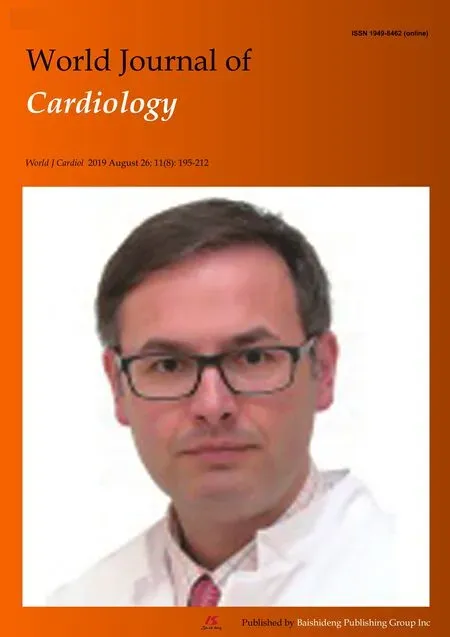Successful minimal approach transcatheter aortic valve replacement in an allograft heart recipient 19 years post transplantation for severe aortic stenosis: A case report
Sravani Avula, Sudhir Mungee, Marco A Barzallo
Sravani Avula, Sudhir Mungee, Department of Cardiovascular Medicine, University of Illinois College of Medicine at Peoria, Peoria, IL 61637, United States
Marco A Barzallo, Key Clinal Faculty, Department of Cardiovascular Medicine, University of Illinois College of Medicine at Peoria, Peoria, IL 61637, United States
Abstract
Key words: Transcatheter aortic valve replacement; Heart transplant; Minimal approach valve replacement; Severe aortic stenosis; Case report
INTRODUCTION
The survival of heart transplant recipients has significantly improved over the past few decades with advanced surgical techniques and immunosuppressive therapies.Valvular diseases like aortic stenosis is seen as one of the late complications in cardiac allograft recipients given improved long-term survival in these patient population[1-3].Aortic valve replacement through median or partial sternotomy has been considered to be the standard treatment of choice[4-6].Over the past decade transcatheter aortic valve replacement has been evolving given that it is less invasive in these high risk transplant recipients[6-10].On review of literature, only 6 case reports have been reported thus far, of which one has been reported in the United States[2,7].Most of the case reports comment only on immediate post-operative outcomes.
CASE PRESENTATION
Chief complaints
Progressive shortness of breath.
History of present illness
A 73-year-old male with history of hypertension, orthotopic heart transplantation 19 years ago has been followed closely for symptoms of worsening shortness of breath in the setting of severe aortic stenosis.His functional capacity has been gradually declined to NYHA Class IV (New York Heart Association).
History of past illness
Hypertension, status post heart transplantation, allograft non occlusive vasculopathy and aortic stenosis.
Personal and family history
Included above.
Physical examination
Physical examination upon admission: He was noted to have elevated jugular venous pulse, bibasilar lung crackles and bilateral pedal edema.
Laboratory examination
None.
Imaging examinations
Follow up transthoracic echocardiograms as per routine protocol did not show any aortic valve disease until 15 years post transplantation when the aortic valve was noted to be mildly sclerotic at that time and gradually progressed to symptomatic severe aortic stenosis over the next 4 years.
FINAL DIAGNOSIS
Symptomatic severe aortic stenosis.
TREATMENT
Transcatheter aortic valve replacement.
OUTCOME AND FOLLOW-UP
Patient had tolerated the procedure well and was discharged home on post procedure day 2.His symptoms of shortness of breath and functional capacity were noted to be significantly improved during post procedure follow up in the clinic.
DISCUSSION
Patient was minimally sedated with subcutaneous lidocaine in bilateral groin sites along with small dose of versed and fentanyl pushes per anesthesia protocol.
The left groin was accessed with a 6 French sheath.A pigtail was advanced for aortoiliac angiography and contralateral access guidance.Aortic root angiography was performed for guidance of valve deployment.A 6 French venous sheath was obtained in the left common femoral vein and a temporary pacemaker was advanced into the right ventricle.With contralateral guidance, a 6 French sheath was placed into the right common femoral artery.Two Preclose devices were deployed and a 16 French sheath was placed.An Amplatz catheter and a Newton wire was advanced,across the aortic valve into the left ventricle followed by advancing a preshaped stiff amplatz wire.Later, the prosthetic aortic valve was advanced across the aortic valve.Once the valve was noted to be in proper position, a 29-mm Sapien 3 valve was deployed in the usual sequence of rapid pacing, balloon inflation and balloon deflation.Once the valve was deployed, transthoracic echocardiography was done that confirmed adequate valve function.No aortic regurgitation was noted.The delivery system and the 16 French sheath and hemostasis was achieved successfully.The left common femoral access sheath was removed and a 6 French Mynx device was placed.No immediate complications were seen.Patient did tolerate the procedure well and was discharged on post op day 2 (Figure1).
CONCLUSION
Minimal approach transcatheter aortic valve replacement has proven to have good outcomes in high risk patients.Its use in allograft heart is also showing to have good immediate post-operative outcomes.All the case reports thus far have commented on immediate post-operative outcomes, but more data is needed in regard to long-term prognosis.There is inadequate data in regard to valvular diseases in heart transplant recipients.Vasculopathy is a well-known complication in this patient population.With the improved survival of these patients, we think it is time to look into pathophysiology of valvular disease in transplant heart recipients.Some other unanswered questions include, underlying donor and recipient risk factors for valvular diseases in heart transplant recipients.

